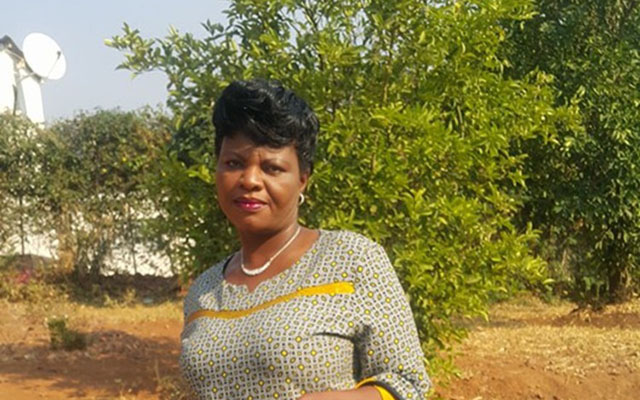Poverty, HIV worsen childhood malnutrition


Save the Children is helping mothers with malnourished babies and providing them with supplements to address that problem . — (Pictures by Tawanda Bote)
Paidamoyo Chipunza Senior Health Reporter
“I was so sick and could hardly walk. I was actually crawling like a baby. I was just not well for the greater part of my pregnancy until delivery,” said Ndakaitei Tamirepi (40) of Kasvisva village in the Nyaminyami district of Kariba.
Ms Tamirepi who delivered her sixth baby at Kasvisva clinic said because of poverty, she was surviving on roasted corn and water, resulting in her becoming malnourished, a condition that also affected her unborn baby who upon birth was heavily underweight.
“At some point, I was referred to Kariba hospital for some tests, since they could not be done here at Kasvisva clinic. But, realising the cost of travelling to and from the hospital and my condition, they later opted to bring the diagnostic equipment to our clinic where they did the tests,” she said.
Ms Tamirepi was diagnosed with HIV. In April 2016, baby Miltrate was born.
“Initially, she did not show any sign of life, I thought I had lost her. It took the nurses some efforts to resuscitate her. Moments later she made her first cry. I felt relieved,” recalled Ms Tamirepi.
She said upon her discharge from the clinic, the plan was to also test her baby for HIV as early as six weeks from birth since she had been exposed at birth, but this did not happen due to lack of resources at the clinic. Miltrate was only tested a year later and tested negative, resulting in Ms Tamirepi abruptly weaning her baby fearing she would transmit HIV through breastmilk.
She said sometime this year, a village health worker visited her home to check on the baby. During her assessments, she found out that the child was malnourished and referred her to the clinic.
“I had stopped breastfeeding and I was feeding her with anything available at that time, but mostly maheu. When the village health worker came, he assessed her and she was found to be malnourished weighing only 4kg,” said Ms Tamirepi in an interview while her husband’s second wife stood a stone’s throw away also holding her seemingly malnourished baby in her arms.
For these women, the look of poverty is all they know having been married to a poor peasant farmer in this remote area where living conditions are harsh. The nearest functional hospital is 300km away. People in this area walk more than 40km to access rural healthcare centres. The route to these centres is risky and infested with elephants, lions and other wild animals.
In this community, health workers play a pivotal role in providing basic health information and services against faith based and traditional healing options. Beyond, the great Kariba dam wall lies the rural face of Kariba – named Nyaminyami after the Tonga people’s god a widely believed snake spirit that lives on the Zambezi valley.
A 200km gravel stretch with a rough terrain, sometimes worn out on either shoulders but still along the mighty Zambezi river takes you to an almost similar community, Binga. Just like rural Nyaminyami, most people in this district live in abject poverty and rely on fishing from the mighty Zambezi river, sadly not for consumption but as a source of income.
In this district, is Simatelele village about 70km from Binga centre where 40-year-old Ms Avinnah Mudimba, the first of four wives married to a former fisherman hails. Just like Ms Tamirepi, Ms Mudimba’s last child who is now nine months old was diagnosed of malnutrition during routine village growth monitoring of infants by village health workers.
Ms Mudimba, together with her husband and one of her husband’s wives are living with HIV. A one-year-old child from the third wife, Ms Delina Muzamba (43 years) whose last HIV test was negative is also malnourished and has been on a feeding scheme since June this year. Ms Muzamba’s daughter, Average (18) who stays with her parents also has a baby who is 15 months old. The baby too, is malnourished.
“Our husband has been unwell for a long time and has not been able to fend for the family so we are surviving on market gardening for both consumption and as a source of income. In total we are 21 in our family and each wife has 27 beds of vegetables,” said the eldest wife, Ms Mudimba.
She said the money was, however, not enough to meet even basic food requirements such that her child fed on maize meal porridge without sugar, salt or peanut butter for the whole day – a diet that could have impacted negatively on the health status of these three children. The third wife, Ms Muzamba said since June her child has been failing to gain weight even though he has been on therapeutic feeding scheme.
“The main challenge has been alternative complimentary food for the child beyond Plumpy’nut so the child keeps relapsing and reverting to the feeding scheme,” she said.
Plumpy’nut is a peanut-based paste used for the treatment of severe malnutrition. These Nyaminyami and Binga families represents an estimated 4,1 million food insecure Zimbabweans (Zimbabwe Vulnerability Assessment Committee report 2017) and a fraction of those that are HIV positive.
According to the report, Kariba and Binga have worst global acute malnutrition (GAM) rates for children under five years accounting for 17 and 11 percent respectively. The national GAM rate stands at 4,4 percent. The report further says one in every four children from these districts are also too short for their ages (stunted).
“This prompted us to start nutritional programmes focusing on these poorest communities in Zimbabwe and of course incorporating children born to HIV positive mothers,” said Mrs Tendai Gunda, a nutritionist working for an NGO – Save the Children.
Mrs Gunda said to reach out to these children, here organisation worked with 2 389 voluntary village health workers throughout the country. She said these village health workers were trained to mobilise villagers, screen, identify cases of malnutrition, which they then refer to the nearest health facility for intervention.
Mrs Gunda said the village health workers were also equipped with essential tools to use in identifying malnutrition such as weight scales and middle-upper arm circumference measuring tapes. Cognisant of the impact of HIV on nutritional status of infants, Mrs Gunda said every child who comes for treatment of malnutrition is offered an HIV test.
“Our aim was to test at least 85 percent of children who come through the nutrition programme so every child who comes for treatment of malnutrition is offered an HIV test and is tested should the mother consent to the test,” said Mrs Gunda.
She, however, said some mothers or caregivers for the children on malnutrition treatment opt against the test, Save the Children has reached to an estimated 70 percent of children living with HIV in Binga and Nyaminyami districts.
Mr Tafungiwa Kwarira, one of the village health workers working with Save the Children in Nyaminyami said they identify cases of malnutrition through home visits and village gatherings.
“We mobilise communities at village level. At these gatherings, we share information on alternative foods for children under five years that is easily available in our community after which we screen them for any symptoms of malnourishment.
He said those who fail to attend the gatherings are then followed up in their homes and receive similar information and services.
“Any child exhibiting any signs of malnutrition is immediately referred to the clinic for management,” said Mr Kwarira.
Apart from food insecurities, HIV and Aids, malnutrition has also been attributable to poor water and sanitation facilities. Save the Children is also assisting in construction of at least 400 improved pit latrines in selected wards of Binga and Kariba.
Ministry of Health and Child Care nutrition officer Mr Dexter Changwena said poor water and sanitation results in diarrhoeal diseases, which takes away all the nutrients in the body resulting in malnourishment.
Mr Chagwena said Government is also working on integration of HIV, TB and malnourishment screening following a 2014 national survey which showed that malnutrition was prevalent in children living with HIV.
Mr Chagwena said continuing with therapeutic feeding on a child with HIV might not yield desired results hence the need to integrate the services for better management and improved outcomes.
“Normally, we expect a malnourished child to start recovering from at least two weeks after commencing therapeutic feeding and cases that keep relapsing or those that do not improve at all could be HIV-related,” said Mr Chagwena.
He said realising that malnutrition was a result of varying social factors, Government has also come up with district food and nutrition committees aimed at mitigating factors leading to malnutrition. These committees comprise of officials from relevant Ministries such as Health, Social Welfare, district administrator and other stakeholders.











Comments